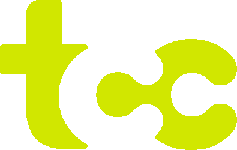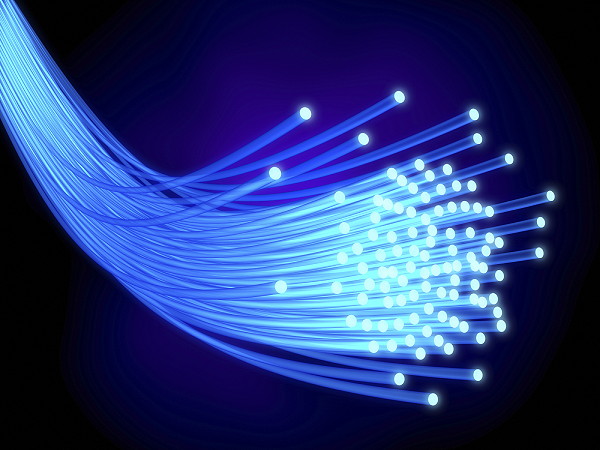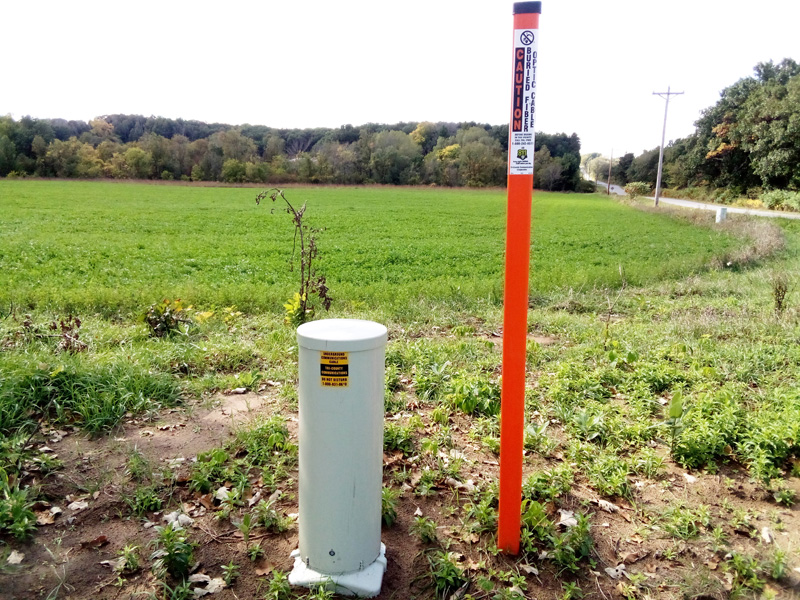Fiber Optic Cables, or “Fiber,” has been one of the biggest buzzwords in telecommunications for the last ten years. What is fiber and what’s so great about it? In this article, we’ll take a look.
So what is fiber? Fiber refers to a data communication cable made from tiny strands of glass tubes. Each tube is a little thicker than a human hair. Fiber can refer to one single strand or the entire bundle of strands wrapped together and encased in a rubber sheathing. A fiber cable is somewhat flexible but it cannot be bent too sharply or it will crack/break. A fiber optic cable is so named because the data is sent through the tubes of glass as beams of light (optical). Think of the old signaling devices on ships that send Morse code via spotlight shutters opened and closed. Fiber uses certain electronics to turn the data into light and then decode the light signals on the receiving end. While it seems “common” these days to hear about fiber, it really is a marvel of science and engineering.
Pro’s and Con’s
Fiber has a number of advantages over its older counterparts — coaxial cable and telephone cable (or “twisted pair”) — including transmission speed, transmission distance, and resistance to moisture and temperature changes. Fiber can transmit at a speed of up to 10 Gbps (10 billion bits per second) whereas cable coax can transmit 25 – 300 Mbps (300 million bits per second) and DSL (copper phone wire) can transmit up to 0.5 – 75 Mbps (500,000 – 75 million bits per second). And that’s ONE STRAND of fiber! Switching to fiber is sometimes called “future-proofing” because a home’s need for Internet will never be able to out-grow the capacity of fiber. Not only that, but a home’s TV and phone services can be carried by the same fiber, without maxing out its capacity. The provider just “turns up more speed.”
Fiber can also transmit its signal much further than cable or DSL without the use of repeaters or other special electronics to clean and re-boost the signal. That means a lot in rural areas where homes and towns might be far apart. Lastly, fiber is less affected by changes in moisture and weather, so its signal will not have interference during spring thaw, heavy rains, super hot or super cold temperatures as much as cable and DSL signals might.
Of course, there are a few downsides to fiber — namely the cost to plow, connect and maintain it. Being tiny strands of glass encased in a sheath means any breakage, splits, cuts, expansions, or upgrades requires more specialized technicians using more specialized equipment and this generally takes more time. That means the cost is higher whenever something goes wrong or needs work done.
The last ‘con’ is that upgrading to fiber often involves plowing and connecting a brand new line, even when there is already a coax or DSL line buried at that location. Everything is different so it requires a brand new plow and connection.
Home Value
Due to the speed, capacity, and need for only one line to the house, adding fiber to the home (FTTH) is said to increase a home’s value by 5% (or $10,000 on a $200,000 home). [2016 study by University of Colorado and Carnegie Melon University] That’s like adding a beautiful deck or a sunroom! Fiber can mean the difference between working or going to school from home or being unable to due to a lack of bandwidth.
Community improvement/potential
Not only does fiber benefit the actual resident in a community, but it really improves a community as a whole. Think of a community with all brand new streets, or brand new water or electric lines? The prospect of moving there would improve! That goes for residents AND businesses! Now imagine if a community had fiber lines to every home and business in a town, that would give it an advantage over another business that did not have such an infrastructure when it came to attracting new residents and businesses.
Our fiber in ILEC/CLEC/Expansion Areas
TCC has fiber-to-the-home across our entire ILEC area. ILEC stands for Incumbent Local Exchange Carrier — or the areas we were designated by the Wisconsin Public Service Commission (PSC) to be the primary phone service provider. Our ILEC area includes the six exchanges of Eleva, Strum, Independence, Northfield, Pigeon Falls, and Pleasantville. In those areas, we plowed lines to every single household and business, both near and far, to provide them service. We have since replaced the copper lines with all fiber from our office all the way to their homes and businesses.
TCC does not have fiber-to-the-home in our CLEC area, but we do have a lot of fiber in place. While we are making new connections with fiber, and we have a lot of fiber between towns and connecting different neighborhoods, it just a complete fiber line from the TCC office into everyone’s homes—- yet! Those new connections include our expansion areas, where we worked with a township and the government to secure funds to connect yet-unserved or underserved areas with fiber, and new developments that are built where we have no current facilities.
Where is fiber? How do you know if you have it?
With TCC, if you are in our ILEC, you have fiber to the home. If you are in our CLEC, you may have FTTH or you may just have fiber somewhere in the path. If you are not in our area, then you would have to check with your provider. Many smaller, rural providers (many of them cooperatives, like TCC) have large portions of their serving areas converted to fiber, but many larger and urban providers have yet to convert much of their areas to fiber. If you are planning to move, and you would like better Internet access, be sure to check into the provider that serves the homes you are looking at to see what services they provide!



